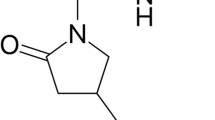Abstract
Brain imaging is a process which allows scientists and physicians to view and monitor the areas of the brain which allow diagnosis and following up different abnormalities in the brain. The aim of this study was to develop potential radiopharmaceuticals for the non-invasive brain imaging. Sibutramine and fluoxetine (two drugs that have the ability to cross blood–brain barrier) were successfully labeled with 125I via direct electrophilic substitution reaction at ambient temperature. The reaction parameters studied were substrate concentration, oxidizing agent concentration, pH of the reaction mixture, reaction temperature, reaction time and in vitro stability of the iodocompounds. The iodocompounds gave maximum labeling yield of 92 ± 2.77 and 93 ± 2.1%, respectively, and maintained stability throughout working period (24 h). Biodistribution studies showed that maximum in vivo uptake of the iodocompounds in the brain was 5.7 ± 0.19 and 6.14 ± 0.26% injected activity/g tissue organ, respectively, at 15 and 5 min post-injection, whereas the clearance from the mice appeared to proceed via the hepatobiliary pathway. Brain uptake of 125I-sibutramine and 125I-fluoxetine is higher than that of 99mTc-ECD and 99mTc-HMPAO (currently used radiopharmaceuticals for brain imaging) and so radioiodinated sibutramine and fluoxetine could be used instead of 99mTc-ECD and 99mTc-HMPAO for brain SPECT.








Similar content being viewed by others
References
Devous MD Sr (2002) Brain mapping: the methods, 2nd edn. Academic Press, New York, pp 513–536
Catafau AM (2001) J Nucl Med 42:259–271
Devous MD Sr (2002) In: Mazziotta JC, Toga AW (eds) Brain mapping: the methods (2nd edn). Academic Press, San Diego, pp 513–533
Lee B, Newberg A (2005) NeuroRx 2:372–383
Bonte FJ, Devous MD (2003) In: Sandler MP, Coleman RE, Patton JA, Wackers FJTh, Gottschalk A (eds) Diagnostic nuclear medicine (4th edn). Lippincott Williams and Wilkins, Philadelphia, pp 757–782
Devous MD Sr (1998) In: Murray IPC, Ell PJ (eds) Nuclear medicine in clinical diagnosis and treatment (2nd edn). McGraw-Hill, New York, pp 631–649
Brooks DJ (2005) NeuroRx 2:226–236
Eckert T, Eidelberg D (2005) NeuroRx 2:361–371
Heinz A, Jones DW, Raedler T, Coppola R, Knable MB, Weinberger DR (2000) Nucl Med Biol 27:677–682
Dickerson BC, Sperling RA (2005) NeuroRx 2:348–360
Bammer R, Skare S, Newbould R, Liu C, Thijs V, Ropele S, Clayton DB, Krueger G, Moseley ME, Glover GH (2005) NeuroRx 2:167–196
Kuzniecky RI (2005) NeuroRx 2:384–393
Ogasawara K, Ogawa A, Ezura M, Konno H, Suzuki M, Yoshimoto T (2001) Am J Neuroradiol 22:48–53
Chang C, Shiau Y, Wang J, Ho S, Kao A (2002) Ann Rheum Dis 61:774–778
Bonte FJ, Hynan L, Harris TS, White CL (2010) J Mol Imaging 2011:ID 409101
Walovitch RC, Hill TC, Garrity ST, Cheesman EH, Burgess BA, O’Leary DH, Watson AD, Ganey MV, Morgan RA, Williams SJ (1989) J Nucl Med 30:1892–1901
Neirinckx RD, Canning LR, Piper IM, Nowotnik DP, Pickett RD, Holmes RA, Volkert WA, Forster AM, Weisner PS, Marriott JA, Chaplin SB (1987) J Nucl Med 28:191–202
“New Drugs” (2002) Australian Prescriber 25:No 1
Messiha FS (1993) Neurosci Biobehav Rev 17:385–396
Greenwood N, Earnshaw A (1997) Chemistry of the elements. Butterworth Heinemann, Oxford
Liu FEI, Youfeng HE, Luo Z (2004) IAEA, Austria, Technical Reports Series No 426, pp 37–52
Rhodes BA (1974) Semin J Nucl Med 4:281
Adam MJ, Wilbur DS (2005) Chem Soc Rev 34:153–163
El-Azony KM (2010) J Radioanal Nucl Chem 285:315–320
Tolmachev V, Bruskin A, Sivaev I, Lundqvist H, Sjöberg S (2002) Radiochem Acta 90:229–235
Puttaswamy, Sukhdev A, Shubha JP (2009) J Mol Catal A 310:24
Puttaswamy, Vaz N (2003) Transit Met Chem 28(4):409–417
Ramalingaiah, Jagadeesh RV, Puttaswamy (2007) J Mol Catal A 265:70
Motaleb MA, Moustapha ME, Ibrahim IT (2011) J Radioanal Nucl Chem. doi:10.1007/s10967-011-1069-z
Suhara T, Sudo Y, Yoshida K, Okubo Y, Fukuda H, Obata T, Yoshikawa K, Suzuki K, Sasaki Y (1998) Lancet 351:332–335
Author information
Authors and Affiliations
Corresponding author
Rights and permissions
About this article
Cite this article
Motaleb, M.A., El-Kolaly, M.T., Rashed, H.M. et al. Novel radioiodinated sibutramine and fluoxetine as models for brain imaging. J Radioanal Nucl Chem 289, 915–921 (2011). https://doi.org/10.1007/s10967-011-1182-z
Received:
Published:
Issue Date:
DOI: https://doi.org/10.1007/s10967-011-1182-z



